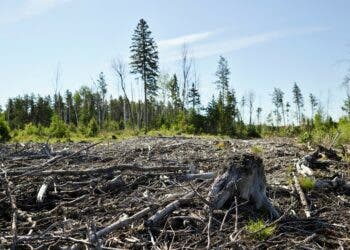We won’t solve the climate crisis by planting a large number of trees around the world. Instead, countries should focus on keeping the existing forest healthy, so they can continue to act as carbon sinks and remove greenhouse gases from the atmosphere through photosynthesis, according to a new commentary piece.

University of Arizona’s researcher David Breshears and his colleague from the University of Michigan Jonathan Overpeck said the world can’t “plant its way out of the climate crisis.” According to the two researchers, the idea of planting trees as a substitute for the direct reduction of greenhouse gas emissions is simply a pipe dream.
“Policymakers need to enable new science, policy and finance mechanisms optimized for the disturbance and vegetation change that is unstoppable, and also to ensure that the trees and forests we wish to plant or preserve for the carbon they sequester survive in the face of climate change and other human threats,” they wrote.
“Tree-planting has great appeal to some climate activists because it is easy and not that expensive,” Breshears said. “But it’s like bailing water with a big hole in the bucket: While adding more trees can help slow ongoing warming, we’re simultaneously losing trees because of that ongoing warming.”
The idea of planting trees as a low-cost and high-impact solution to climate change increasingly pops up time and time again. Previous studies have highlighted the potential of trees to soak up and store carbon, with countries like the US and the UK starting massive tree-planting campaigns as part of their climate plans.
But it’s not that simple. There are many tree-planting initiatives underway across the globe, all of which aim to capture carbon to compensate for the huge carbon dioxide emissions that are a major cause of rising global temperatures. But in some cases, they don’t actually increase carbon capture and instead have negative consequences.
Breshears and Overpeck said policymakers and land managers have to acknowledge that additional vegetation changes are inevitable. Climate change has recently been linked to record-setting wildfires in the United States and Australia, for example. These trends are expected to accelerate as the climate warms, the researchers argued.
“Even in a world where climate change is soon halted, global temperature rise will likely reach between 1.5 and 2 C above pre-industrial levels, with all the associated extreme heat waves that brings, and thus global vegetation will face up to double the climate change already experienced,” they wrote.
While climate change is accelerating, deforestation continues to expand globally and is especially damaging in tropical forests, which hold vast amounts of biodiversity and sequestered carbon, Breshears and Overpeck said. Last year, at least 42,000 square kilometers of tree cover were lost in key tropical regions such as the Amazon basin.
Two-thirds of global forest cover loss is occurring in the tropic and subtropic regions of the world, where vast clusters of deforestation hot spots are destroying the important ecosystem services forests provide. There are 24 of these hot spots that are spread across Latin America, sub-Saharan Africa, Southeast Asia, and Oceania.
The researchers advise countries to manage forests proactively for the vegetation changes that can be anticipated, instead of trying to maintain forests as they were decades ago. This means more aggressive thinning of forests to reduce the buildup of fuels that increase wildfires and replace trees that aren’t in optimal climate zones.
While these actions will increase the cost of forest management, Breshears and Overpeck described it as a prudent investment, helping to preserve the service of carbon capture provided by forests. Capturing carbon should rank high on the list of invaluable services that forests provide, and efforts to preserve it should be funded.
“Thinning of forests, conversion of the removed wood to biochar and burial of the biochar in forest soils is a way to bring new jobs to forested rural areas while allowing forests to play a bigger role in keeping carbon out of the atmosphere and thus fighting climate change. Forest carbon management could be a boon for rural areas in need of new economic engines,” the researchers wrote.
The commentary was published in Science.






